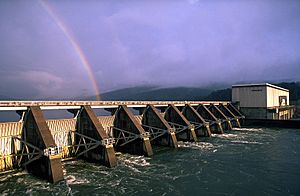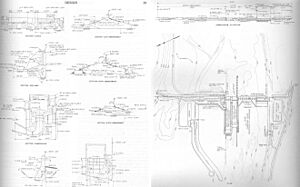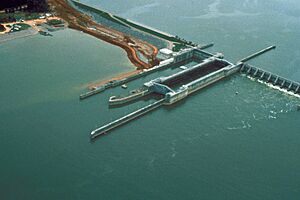Nickajack Dam facts for kids
Quick facts for kids Nickajack Dam |
|
|---|---|

Nickajack Dam looking upstream
|
|
| Official name | Nickajack Dam |
| Location | Marion County, Tennessee, United States |
| Coordinates | 35°00′15″N 85°37′10″W / 35.00417°N 85.61944°W |
| Construction began | April 1, 1964 |
| Opening date | December 14, 1967 |
| Operator(s) | Tennessee Valley Authority |
| Dam and spillways | |
| Impounds | Tennessee River |
| Height | 81 ft (25 m) |
| Length | 3,767 ft (1,148 m) |
| Reservoir | |
| Creates | Nickajack Lake |
Nickajack Dam is a large hydroelectric dam in Marion County, Tennessee. It is one of nine dams on the Tennessee River managed by the Tennessee Valley Authority (TVA). The TVA built Nickajack Dam in the mid-1960s. It replaced an older dam called Hales Bar Dam, which was about 6 miles (10 km) upstream.
The dam creates a large body of water called Nickajack Lake, which covers about 10,370 acres (4,197 ha). Water from Nickajack Lake then flows into Guntersville Lake. The dam is named after a Cherokee village that used to be upstream. This village is now underwater. Nickajack Cave was also partly flooded by the lake.
Contents
Where is Nickajack Dam Located?
Nickajack Dam is located 424 miles (682 km) from where the Tennessee River flows into another river. It is near the spot where Tennessee, Georgia, and Alabama meet. This part of the river is where it leaves the Tennessee River Gorge. The gorge used to be a very tricky part of the river to travel through.
The Sequatchie River flows into the water just below the dam. The city of South Pittsburg is about 5 miles (8 km) downstream. Nickajack Lake stretches northeast for over 46 miles (74 km). It reaches all the way to the base of Chickamauga Dam in Chattanooga. Tennessee State Highway 156 runs just south of the dam. Interstate 24 is a few miles to the north.
How Big and Powerful is Nickajack Dam?
Nickajack Dam is 81 feet (25 m) tall and 3,767 feet (1,148 m) long. Its lake, Nickajack Lake, has 179 miles (288 km) of shoreline. The lake's surface covers 10,370 acres (4,197 ha). The dam has 10 gates that can release a lot of water. Together, they can let out 360,000 cubic feet (10,000 m³) of water per second.
The dam also generates electricity. It can produce 104 megawatts of power. This is enough to power many homes and businesses.
How Do Boats Pass Through the Dam?
Nickajack Dam has a special "lock" system for boats. This lock is 600 feet (180 m) long and 110 feet (34 m) wide. It can lift or lower up to nine large barges at once. The lock moves boats 41 feet (12 m) between Guntersville Lake and Nickajack Lake. The original plan for the dam included an even bigger main lock, but it was never built. The U.S. Army Corps of Engineers operates and maintains all the locks on the Tennessee River.
Why Was Nickajack Dam Built?
Before 1913, the Tennessee River Gorge was very dangerous for boats. It had many tricky spots with strong currents. These spots had names like "The Suck" and "The Skillet." In the early 1900s, the U.S. Army Corps of Engineers realized a dam could help. A dam at the end of the gorge would flood these dangerous spots. This would make the river safer for travel.
Josephus Conn Guild, an engineer from Chattanooga, offered to help. He would raise money for the dam if he could use its electricity. He started a company called the Chattanooga and Tennessee River Power Company in 1905. They began building Hales Bar Dam that same year.
Problems with the Old Dam
Hales Bar Dam had a big problem: its foundation was weak limestone. This caused many leaks from the start. Even after it was finished in 1913, the dam kept leaking. In 1939, the Tennessee Valley Authority (TVA) took over Hales Bar Dam. The TVA tried to fix the leaks, and by 1943, they had stopped.
However, by 1960, the leaks returned. Water was pouring out at a rate of 2,000 cubic feet (57 m³) per second. At the same time, the TVA wanted to make the locks on its dams bigger. This was because river traffic had increased a lot since World War II. Making the Hales Bar lock bigger would be too expensive. So, in 1963, the TVA decided to build a brand new dam. They chose a spot a few miles downstream with much stronger rock for the foundation.
Building Nickajack Dam
The plan for Nickajack Dam was approved on January 9, 1964. Construction began quickly on April 1, 1964. Money that was set aside to fix Hales Bar was used for the new Nickajack project.
Building the new lake meant buying about 8,300 acres (3,400 ha) of land. About 500 acres (200 ha) of this land had to be cleared. Eighty-two families had to move their homes. About 8 miles (13 km) of roads also had to be relocated. Some parts, like two generators, were moved from Hales Bar Dam to the new dam.
Construction of Nickajack Dam finished on December 14, 1967. It cost about $73 million. The very next day, Hales Bar Dam stopped working. By September 1968, Hales Bar Dam was taken apart. Its lake then became part of Nickajack Lake.



